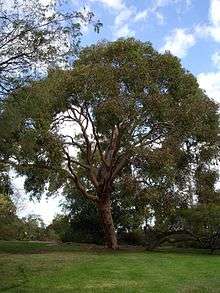Angophora
| Angophora | |
|---|---|
 | |
| Angophora costata | |
| Scientific classification | |
| Kingdom: | Plantae |
| (unranked): | Angiosperms |
| (unranked): | Eudicots |
| (unranked): | Rosids |
| Order: | Myrtales |
| Family: | Myrtaceae |
| Genus: | Angophora Cav. |
Angophora is a genus of flowering plants in the myrtle family, Myrtaceae, described as a genus in 1797.[1][2] It is endemic to Australia, where species are distributed in Queensland, New South Wales, and Victoria.[3] The centre of diversity is along the northern and central coast of New South Wales.[4]
Taxonomy
Angophora is closely related to Corymbia and Eucalyptus, and all three genera are often referred to as "eucalypts". Collectively the eucalypts, or gum trees, dominate many Australian ecosystems.[5] Angophora can be distinguished from other eucalypts by its oppositely arranged leaves and flowers which lack opercula, cap-like structures which fall off as the flowers open.[6] Taxonomists have long recognised the relationships between the eucalypt taxa, but have not agreed upon a classification scheme. Some have proposed merging Angophora and Corymbia into genus Eucalyptus as subgenera,[7] a plan which was immediately rejected by others.[8] Some authors maintain Angophora as a genus,[9] while others continue to debate the issue.[10][11]
Among the eucalypts, Angophora species were nicknamed "apples" by European settlers, who thought they resembled apple trees.[6] Many are still known commonly as apples today.[4]
Description
Angophora are trees and shrubs. Most have rough bark. The opposite leaves are hairy and glandular when new, and mostly hairless when mature. The inflorescence is an arrangement of several clusters of 3 to 7 flowers each. The flower has 4 or 5 small, green sepals, overlapping white petals, and whorls of many stamens. The fruit is a papery or slightly woody capsule, usually with thick ribs and a coat of hairs.[4][12]
Species
- Angophora bakeri (narrow-leaved apple). A tree up to 10 metres tall. - NSW
- Angophora costata (smooth-barked apple, Sydney red gum, rusty gum). A tree up to 30 meters tall with smooth, scaly bark. Often on sandstone. - NSW
- Angophora × clelandii - hybrid A. bakeri × A. hispida - NSW
- Angophora crassifolia, a tree up to 15 meters tall endemic to New South Wales. - NSW
- Angophora × dichromophloia - hybrid, A. costata × A. hispida - NSW
- Angophora euryphylla, a tree up to 25 meters tall. - NSW
- Angophora exul, a threatened species known only from a small area at Gibraltar Rock, New South Wales. A tree up to 8 meters tall with compound, terminal inflorescences. - NSW
- Angophora floribunda (rough-barked apple). A common tree up to 30 metres tall - NSW, Qld, and Vic
- Angophora hispida (dwarf apple, banda). A tree or mallee up to 7 meters tall. - NSW
- Angophora inopina, a vulnerable species. A tree up to 8 metres tall. - NSW
- Angophora leiocarpa, a tree up to 25 meters tall. - NSW, Qld
- Angophora melanoxylon (Coolabah apple). A multi-stemmed tree up to 15 metres tall. - NSW, Qld
- Angophora paludosa, a tree up to 15 metres tall. - NSW
- Angophora robur, a vulnerable species. A tree up to 10 metres tall. - NSW
- Angophora subvelutina (broad-leaved apple). A tree up to 20 metres tall. - NSW, Qld
- Angophora woodsiana, a tree up to 20 metres tall. - NSW, Qld
References
| Wikimedia Commons has media related to Angophora. |
- ↑ Cavanilles, Antonio José. 1797. Icones et Descriptiones Plantarum 4: 21
- ↑ Tropicos, Angophora Cav.
- 1 2 Kew World Checklist of Selected Plant Families
- 1 2 3 4 Genus Angophora. PlantNET. National Herbarium of New South Wales, Royal Botanic Garden, Sydney.
- ↑ Eucalyptus, Corymbia and Angophora. Australian Native Plants Society.
- 1 2 Eucalyptus, Corymbia and Angophora – Background. Australian Native Plants Society.
- ↑ Brooker, M. I. H. (2000). A new classification of the genus Eucalyptus L'Her.(Myrtaceae). Australian Systematic Botany 13(1), 79-148.
- ↑ Ladiges, P. Y. and F. Udovicic. (2000). Comment on a new classification of the eucalypts. Australian Systematic Botany 13(1), 149-52.
- ↑ Steane, D. A., et al. (2001). Development and characterisation of microsatellite loci in Eucalyptus globulus (Myrtaceae). Silvae Genetica 50(2), 89-91.
- ↑ Brummitt, R. K. (2003). Further dogged defense of paraphyletic taxa. Taxon 52(4), 803-04.
- ↑ Nelson, G., et al. (2003). Brummitt on paraphyly: a response. Taxon 52(2), 295-98.
- ↑ More about Angophora. EUCLID: Eucalypts of Australia, Third Edition. Centre for Plant Biodiversity Research. 2006.
External links
- Angophora costata. Growing Native Plants. Centre for Australian National Biodiversity Research, Australian National Herbarium.